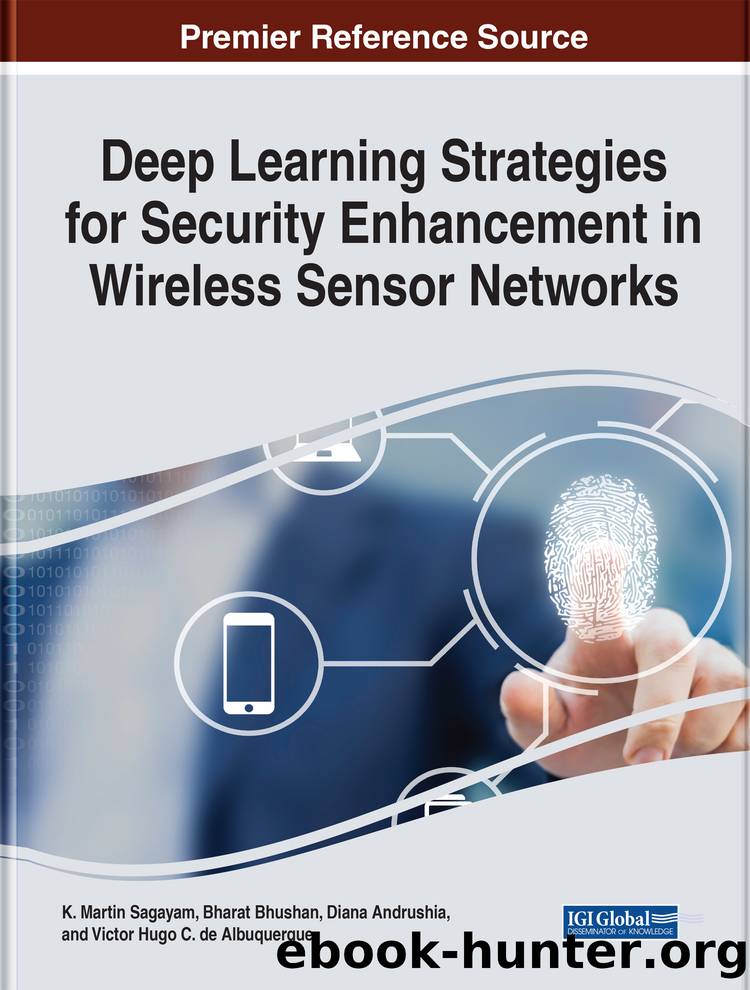Deep Learning Strategies for Security Enhancement in Wireless Sensor Networks by Sagayam K. Martin

Author:Sagayam K. Martin
Language: eng
Format: epub
Publisher: Information Science Reference
In information gathering phase, when the portable sink reaches every RP/SRP each time, chooses whether to request for tree-rebuilt based on the remaining power proportion of its single-bounce closest hub. If it meets the constraints, the intended RP/SRP make the request to the portable sink after it comes. At last, the sink determines about tree rebuilt according to the based on the quantity of requests to the number of RPs and SRPs.
Figure 3. Flowchart of SCBDCA scheme
The flowchart of SCBDCA algorithm is shown in figure 3. Initially consider a homogeneous network with 50 nodes. The nodes are clustered depending upon the geographic location of the nodes. Once the nodes are clustered, CH is selected based on the remaining power and the utilization of the node to its nearby hubs. To balance the data gathering latency, a mobile sink is introduced in each zone to see all CH of that zone for data collection. The new algorithm introduced in this paper is the speed control mechanism which is mainly used to control the speed of the portable sink. The remoteness among the portable sink and CHs are calculated and the average distance is taken as the threshold. If the distance is found to be exceeding the fixed limit, increase the speed of the mobile sink else the speed is decreased or adjusted accordingly depending upon the distance.
Algorithm of SCBDCA Scheme:
For the mobile sink (MS)
if distance > threshold
increase speed
else
decrease speed
Download
This site does not store any files on its server. We only index and link to content provided by other sites. Please contact the content providers to delete copyright contents if any and email us, we'll remove relevant links or contents immediately.
Grails in Action by Glen Smith Peter Ledbrook(9163)
Sass and Compass in Action by Wynn Netherland Nathan Weizenbaum Chris Eppstein Brandon Mathis(8808)
Azure Containers Explained by Wesley Haakman & Richard Hooper(7444)
Configuring Windows Server Hybrid Advanced Services Exam Ref AZ-801 by Chris Gill(7435)
Kotlin in Action by Dmitry Jemerov(7263)
Running Windows Containers on AWS by Marcio Morales(6986)
Microsoft 365 Identity and Services Exam Guide MS-100 by Aaron Guilmette(5402)
Microsoft Cybersecurity Architect Exam Ref SC-100 by Dwayne Natwick(5213)
Combating Crime on the Dark Web by Nearchos Nearchou(4982)
The Ruby Workshop by Akshat Paul Peter Philips Dániel Szabó and Cheyne Wallace(4671)
Management Strategies for the Cloud Revolution: How Cloud Computing Is Transforming Business and Why You Can't Afford to Be Left Behind by Charles Babcock(4527)
Python for Security and Networking - Third Edition by José Manuel Ortega(4233)
The Age of Surveillance Capitalism by Shoshana Zuboff(4210)
Learn Wireshark by Lisa Bock(4123)
The Ultimate Docker Container Book by Schenker Gabriel N.;(3888)
Learn Windows PowerShell in a Month of Lunches by Don Jones(3681)
DevSecOps in Practice with VMware Tanzu by Parth Pandit & Robert Hardt(3568)
Windows Ransomware Detection and Protection by Marius Sandbu(3543)
Blockchain Basics by Daniel Drescher(3507)
